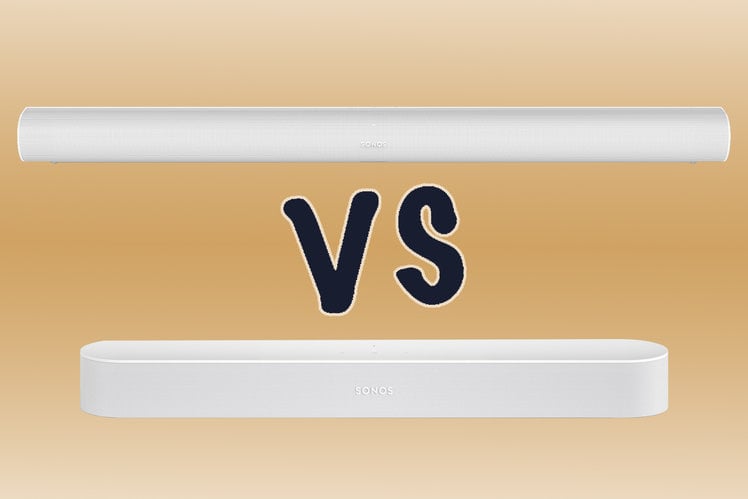
Sonos added a new soundbar to its range in 2020 – the Sonos Arc – succeeding the then seven year-old Playbar. You can read how the two compare in our separate feature.
Arc is a full-fledged, Dolby Atmos sound system, with HDMI eARC, Alexa and Google Assistant support, plus several other bells and whistles. The Sonos Beam meanwhile, is a smaller, more compact and cheaper soundbar.
So which is the better Sonos soundbar for your setup? We compare the Arc and the Beam to help you decide.
Design and connections
- Sonos Arc: 1141.7 x 87 x 115.7mm, 6.25kg, HDMI eARC (optical adapter included)
- Sonos Beam: 651 x 68.5 x 100mm, 2.8kg, HDMI ARC (optical adapter included)
- Both require broadband and power supply
You only need look at the two soundbars to see that there’s an obvious difference in design aesthetic. Both can be wall-mounted or set on a TV stand, but the Beam is more likely to be found on the latter. It is small enough to be fairly anonymous when sat in front of a television.
The Arc is much longer and more soundbar in shape.
The Beam is very much designed for use with a smaller television – 32 to 50-inches, for example. It greatly enhances the sound experience when compared to a smaller set’s built-in speakers, and happily sits out of the way when placed in front.
The Arc, on the other hand, looks more like a traditional soundbar and is likely to be matched with much larger TVs.
In terms of connectivity, both devices have 2.4GHz Wi-Fi and Ethernet ports to hook up to your home network and the internet, but the Arc ups the ante when it comes to connection to a TV.
That’s because it comes with a HDMI port supporting HDMI eARC, with the Beam’s port supporting the older HDMI ARC standard instead.
This is mainly because the Sonos Arc requires more bandwidth to receive Dolby Atmos and higher resolution audio streams. A HDMI ARC connection can do, but the TV must support Dolby Atmos itself.
Sound
- Sonos Arc: 8 woofers, 3 tweeters – with Dolby Atmos
- Sonos Beam: 4 woofers, 1 tweeter
- Both have Class-D digital amplifiers to match speaker drivers
Naturally, the Beam is not as capable when it comes to audio presentation as its newer, larger sibling.
It sports four mid-range drivers and one tweeter for a clean, clear front-facing audio experience. That provides a better soundscape than most TVs are capable.
In comparison, the Sonos Arc has eight drivers and three tweeters, with angled speaker units left and right, plus two angled upwards specifically for use with Dolby Atmos soundtracks.
This effectively means that the Arc provides a wider, taller soundscape that is clearly going to be more immersive.
Both speakers though can be added to, with the Sonos Sub a great option for extra bass and a couple of Sonos One or Sonos One SL speakers good options to provide rear channels to a home cinema setup.
Features
- Sonos Arc: HDMI CEC and auto sync, Alexa and Google Assistant on-board, Apple AirPlay 2
- Sonos Beam: HDMI CEC with optional sync, Alexa and Google Assistant on-board, Apple AirPlay 2
Both the Arc and Beam are Sonos speakers first and foremost, so while they are great at expanding and enhancing TV viewing, they also work well to play music through, either standalone or as part of a Sonos multiroom system.
Both have Alexa and Google Assistant support, so can be voice controlled and work as voice assistants for search and even controlling the rest of your smart home devices.
Both also have HDMI CEC capabilities, allowing you to control your TV, soundbar and any other connected devices with just one remote (you can also opt for IR control, if you so desire).
Basically, the only main difference in features (apart from eARC support and Dolby Atmos) is that the Sonos Arc has audio sync an automatic option, while you have to enable it on the Beam.
Price
Naturally, considering the Arc has more speaker units inside, is larger and has more audio functionality, it is more expensive. And that might be a major factor in your purchasing decision.
The Sonos Beam is usually £399 / $399, for example, in comparison to £799 / $799 for the Sonos Arc. That’s half the price. If you have a smaller TV/living room, you might never need the extra oomph of the Arc and therefore can save yourself a packet.
However, for a smart Dolby Atmos-capable soundbar, with Alexa and Google Assistant on board, and the enter suite of Sonos streaming abilities, the Arc is actually very reasonable if you do fancy splashing out more on your home entertainment.
Conclusion
The biggest decision to make is what you actually want your soundbar to do. If you simply need something to improve the audio performance of your TV viewing, while also presenting all the cool music streaming features of a Sonos system, the Beam could be more than ample for you.
But, if you are looking for a neat home cinema system that has plenty of room for new features in future, the Arc is a very compelling offering – one without compromises. Albeit at a heftier price point.
